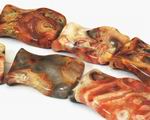


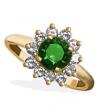
|
|
|
|
|
Emerald, Bead Shapes & Jade
You have received this newsletter because you opted after a past purchase, but should you wish to be taken off the mailing list, just click the link at the bottom. This month’s theme is May's birthstone emerald + bead shapes, jade, and a tall bead story! Scroll down, or click one of the links below on the html version to go to a certain section. If you have any suggestions for the future, please e-mail me at suggestions@mrbead.com. To go to the MrBead store click here
May's Birthstone - Emerald
Bead Shapes
Buying Jade for Jewelry
Knotting a Jade Necklace
How to make a simple Jade Bracelet
History of Jane
Types of Jade
Where Does Jade Come From
Quality of Jade
Tall Stories - Genuine Imitation Beads!
May's Birthstone -
Emerald



Emerald is known as the gem of Spring. This beautiful
green stone is a variety of Beryl and was thought to foretell the future. The
ancients of Peru, believed the Emerald ripened like the fruit of the tree,
turning from clear to green as it faced the sun. The stone was carried by
travelers on land or sea as a talisman to safe guard the journey.
Beryl is often unknown, even through it is one of the most important gems. Beryl is colorless in pure form, but many impurities give its varied coloration. Emerald is the green variety and aquamarine is the blue variety of beryl.
Emerald's precious green color is caused by small amounts of chromium and enhanced by traces of iron. Unlike other beryls, emeralds usually contain inclusions and other flaws. These flaws are not looked on as negative aspects for emerald like they would be for other gemstones. Indeed, these flaws are considered part of the character of the stone and are used to assure the purchaser of a natural stone.
Nearly all emeralds have been treated to improve clarity, generally by immersing them in oil. For gemstones, a green colored oil is often used. Unfortunately, this oil may evaporate over time, making flaws appear where none were visible. A high-grade mineral oil may be used to improve the appearance again. top of page
Bead Shapes
Not all beads are round. Hard stones can be carved into
almost any shape, although many are cut to similar facets as natural crystal
gems like diamonds. Furthermore, these faceted beads need not be round either -
they can be made oval, square, rhombus, and a whole range of other forms. Beads
of differing shape add interest to the design of a necklace or bracelet.
Many shapes are obvious like “heart” or “leaf” - but others, like “briolette” or “rombus” are not so well know. As a beader, you should familiarize yourself to the standard shapes available, so you know what you will be getting without looking at a picture. Don’t forget beads are three-dimensional: so round or oval can also be flat or puff. Pillow can be rectangle or square, and nugget can be almost any shape not uniform (sometimes called freeform).
Below is a list of the most common shapes: Stone Properties
 Abacus |
 Barrel |
Bicone |
||
 Briolette |
 Button |
 Bottle |
||
 Cabochon |
 Capsule |
 Cube |
||
 Disc |
 Dog Bone |
 Donut |
||
 Drum |
 Fancy Drop |
 Flower |
||
 Heart |
 Puff Heart |
 Hour-glass |
||
 Leaf |
 Moon |
 Nugget |
||
 Flat Oval |
 Puff Oval |
 Pillow |
||
 Rhombus |
 Rectangle |
 Wavy Rectangle |
||
 Rice |
 Ring |
 Rondell |
||
 Round |
 Faceted Round |
 Spangle |
||
 Square |
 Wavy Square |
 Star |
||
 Triangle |
 Teardrop |
 Tube |
Buying Jade for Jewelry
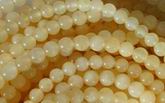
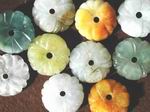
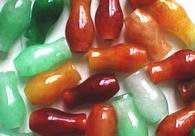
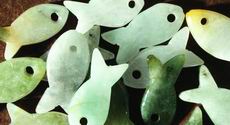
To make jewelry, jade is available in loose beads and temporarily
strung into strands. Loose beads are
cheaper, but beads on strands will hang better making them best for necklaces. However, if you plan on knotting your
necklace, then loose beads may be all right.
Usually each strand, or string in the
Knotting a Jade Necklace

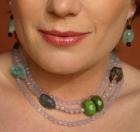
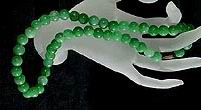
Many of your finer beaded
jewelry is knotted because knots keep the beads from rubbing against each other
- and if the necklace breaks, beads won’t go flying. Knotting also makes the
necklace drape nicely and adds length so you need less beads.
There are a few ways to knot a necklace, but this the
easiest for beginners. First, you’ll need to choose your cord - usually between
silk and nylon. Silk is traditional,
however many complain that it snags and frays. Both come in a variety of
colors. They can be purchased on small cards with about 6 feet of cord and a
needle attached or, for the serious knotter, larger spools can be purchased
with separate needles. They also come in different sizes. The thicker cord is
used for the larger beads since the holes in the beads are larger. For the
beginner’s technique, two strands are put through each bead, so a thinner size
is needed. For 6mm beads, use size 2 for this technique, and try to match the
color of the cord with the color of the beads.
A very-popular way to start any beaded necklace is with bead tips (clamp shells). The only difference here is that two strands of the cord are inserted through the bead tip instead of one. Once the necklace is started, string on a bead, and make an over hand knot. Make the knot tight so it’s snug up against the bead. Continue to do this: string a bead, make an over hand knot, string a bead, make an over hand knot. That’s it. Finish the necklace as you would any beaded necklace whether it’s knotted or not. This beginner’s way is a lot easier than using one strand of cord, and the results look almost the same. top of page
How to Make a simple Jade Bead Bracelet
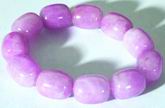
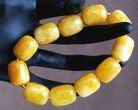

To make a bracelet using elastic, to go with a necklace, only take a few
minutes and is a great way to use up the few extra beads left over. Arrange the
beads to form a 7 inch long bracelet as standard. Once you have your beads
arranged take your spool of elastic and string the beads without cutting a
length of elastic. This will keep your beads in place. To finish, a larger
complementary bead for the end looks attractive. Pull both ends of the elastic
through this bead, and then pull both ends through a small crimp bead. Then
flatten the crimp bead with pliers to secure the beads.
History of Jade
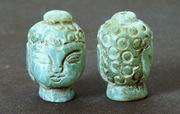


For 5,000 years Imperial China used the word "jade" as something
precious - as in English we use gold. Because the Chinese believe jade has all the
attributes most valued in society. A symbol of purity and serenity, it is
delicate, but will not break - is beautiful, but not impermanent, it can be
flawed with lines, but still pleasing. It is believed to radiate divine
unconditional love and balance the emotions. Held in the hand it can
improve judgment - ancient silk traders often held jade while bartering.
A small piece of jade worn around the neck was said to dispel illness.
Chinese jade first arrived in the West during the
sixteenth century, brought from
Jade was thought to preserve the body after death and can be
found in emperors' tombs from thousands of years ago. One tomb contained an
entire suit made out of jade, to assure the physical immortality of its owner. Jadeite is also thought to cure kidney stones
and other kidney ailments.
top of page
Types of Jade


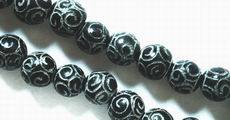

The most famous type of jade carved in
Jade is remarkably tough, used by many early civilizations for axes, knives and weapons. Because of its smooth even texture, jade was soon carved into ornaments - and it wasn't until 1863 that it was realized that Jade was being applied to two different minerals: jadeite and nephrite. Jadeite is almost never found in individual crystals and is composed of microscopic interlocking crystals that produce a very tough material. The nephrite variety is composed of fibrous crystals inter-twinned in a tough compact mass. Nephrite is more abundant than jadeite and has fewer color varieties - usually less intense dark spinach greens, white, browns, and black.
Where Does Jade Come From?


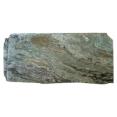

Most jadeite today is mined in
Quality of Jade

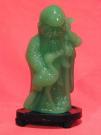

Jade is most often sold by the piece rather than per carat.
Although the overall color is the most important value factor, attention is
also paid to translucency, texture, and also to pattern. Certain patterns,
including moss in snow, are highly valued. Both jadeite and nephrite are very
durable and tough, although jadeite is slightly harder than nephrite due to its
microcrystalline structure.
The top jadeite jade is usually cut into smooth dome shapes called cabochons. Jadeite bangles are also very popular in Asian countries. Beads are also very beautiful and some important jadeite necklaces made during the art deco period have fetched hundreds of thousands of dollars in auctions in the past few years.
Tall Stories - Genuine Imitation Beads!
A young couple from the Midwest decided to spend their honeymoon in California.
They enjoyed the weather and walking along the boardwalks with all of the small
shops. In one of the shops they found a case with a sign saying "Genuine
Imitation" next to a display of beautiful necklaces. The wife looked through the
selection and found one that she really loved. It was a bit pricey, but the
husband wanted to buy his bride a memento of the honeymoon trip so they left the
store with an amber colored necklace of carved beads.
The necklace was a favorite and she wore it on many occasions, always thinking
of their honeymoon when she did. After 20+ years the necklace finally broke. She
took it to her local jeweler to ask if he could restring it for her. He said
that it should not be a problem and took out his loop to look at the beads.
While still examining the necklace he asked if she would be willing to sell it
and offered her $1,000 for it. She very indignantly said "No - it was a gift
from my husband, and anyway why would you pay $1,000 for imitation beads?" The
jeweler did not answer her question, but did restring the necklace as she
requested.
When she returned home, her husband was just as surprised as she was at the
jewelers' offer. He was planning a business trip to New York City and told his
wife that he would take the necklace along and if he had time he would stop at
one of the famous jewelry stores there and see if they would appraise it for
him. He did get time to stop at a jewelry store while he was in New York and
they did agree to look at the necklace for him. The jeweler promptly asked him
if he wanted to sell the piece and offered him $3,000 for it. The husband said,
"Please tell me what is going on, why would someone offer us $1,000 and then
$3,000 for a necklace made up of genuine imitation beads? I do not understand"
To which the jeweler replied "You have never looked at these beads with a loop,
have you?"
"Of course not, why would we?" replied the husband. The jeweler then went on to
explain that the beads were actually carved amber, not imitation anything, and
that each of the beads was inscribed: To Josephine from Napoleon 18xx.
top of page
Special Offer Worth 10% Off !
To sample our beads with 10% off
in our MrBead bead store, just key in "april" at the checkout (without the
inverted commas) and click "Redeem Coupon". The more you
spend - the more you save!
Offer valid until May 8th only - so act now! Only for use in our store at the checkout and not valid with any other offers. To go to the store click here
To see our loose jade beads click
here
To see our strand jade beads click
here
To see our jade necklaces click
here
To see our jade rings click
here
Too see our jade bracelets click
here
To see our store front, click MrBead.com
|
|
|
|
|
|
|
Subscribe Unsubscribe |
|
To return to the top of page click here